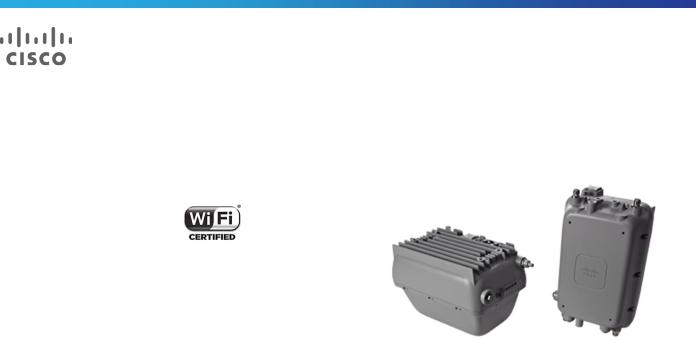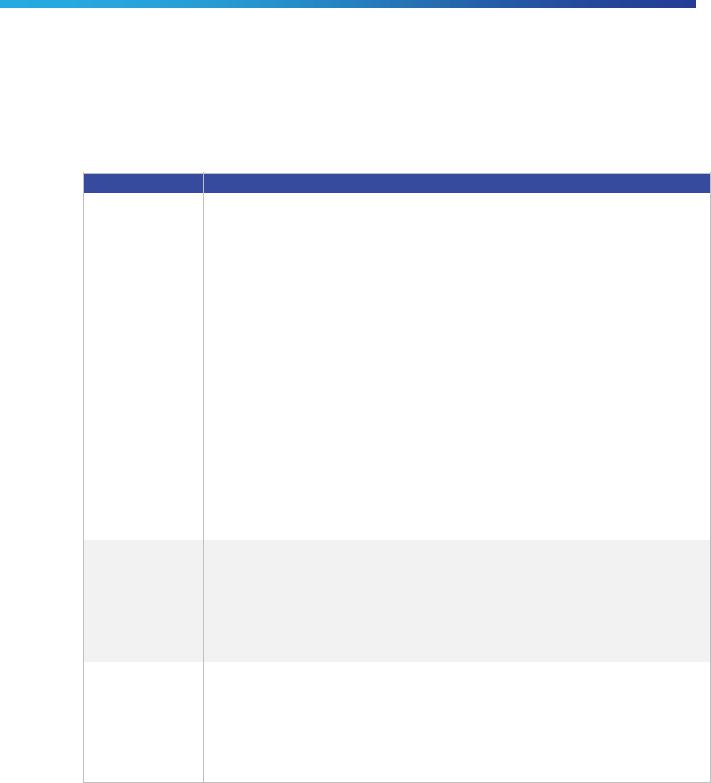Cisco Aironet 1572EAC User Manual

Data Sheet
Cisco Aironet 1570 Series Outdoor Access Point
|
|
|
|
|
|
|
Next-Generation Outdoor Wireless Access Points: |
|
|
Cisco Aironet 1572EAC, 1572IC, and 1572EC |
|
|
|
|
|
● Most advanced carrier-grade outdoor Wi-Fi AP |
|
|
● 802.11ac dual-band (2.4 and 5 GHz) radios |
|
|
● Maximum radiated RF power allowed by law |
|
|
● Industry’s only 4x4, 3-spatial-stream outdoor AP |
|
|
● 1.3 Gbps (5 GHz) WLAN RF data rates |
|
|
● Cisco Flexible Antenna Port technology |
Product Overview |
|
|
|
|
● Uplink: Fiber/SFP, GE, Cable Modem |
Highest-Performing Outdoor Wireless AP |
|
● DOCSIS3.0 with 24x8 channel bonding |
|
|
|
|
|
● Power: AC, DC, Cable, UPOE, PoE-Out (802.3at) |
The Cisco Aironet 1570 Series outdoor access point is ideal for |
|
● 4G LTE coexistence |
|
|
both enterprise and carrier-class network operators looking to |
|
|
● Module option: Investment protection and future |
|
|
|
|
|
proofing |
extend Wi-Fi coverage outdoors. It’s the industry’s highest- |
|
● Low visual profile design |
performing outdoor AP and supports the latest Wi-Fi standard, |
|
● Controller-based or standalone operation |
|
|
|
|
|
● Cisco Aironet 1572EAC |
802.11ac, with data connection speeds up to 1.3 Gbps. This |
|
|
|
|
◦ External antenna with AC-power model |
industrial-grade AP supports 4x4 multiple-input and multiple- |
|
● Cisco Aironet 1572IC |
output (MIMO) smart antenna technology and three spatial |
|
◦ Internal antennas with cable modem model |
|
|
streams for optimum performance. |
|
|
● Cisco Aironet 1572EC |
|
|
|
|
|
◦ External antenna with cable modem model |
The Aironet 1570 provides higher throughput over a larger area |
|
|
|
|
|
with more pervasive coverage. The AP is also well suited to |
high-density environments where many users in close proximity generate RF interference that needs to be |
||
managed. Examples of environments that can benefit from the Aironet 1570 Series: |
||
●Outdoor enterprise campuses
●Outdoor university and school campuses
●Public venues: stadiums, train stations, airports
●Service provider networks: Wi-Fi offload for mobile, fixed-line, and cable operators
●Mining operations
●Manufacturing yards
●Municipalities
●Large metropolitan areas
© 2015 Cisco and/or its affiliates. All rights reserved. This document is Cisco Public Information. |
Page 1 of 12 |

Features and Benefits
The Cisco Aironet 1570 Series meets the demanding needs of customers across a broad range of industries spanning enterprises and service providers. It offers a scalable and secure mesh architecture for high-performance Wi-Fi services. It also addresses the expanding demand for Wi-Fi access services, network-to-network mobility, video surveillance, and cellular data offload to Wi-Fi.
The Cisco 1570 builds and expands on the successful 1550 series legacy of being the Wi-Fi outdoor AP of choice by service providers needing carrier-grade, ruggedized devices that are easy to deploy and maintain.
Table 1 describes the Aironet 1570’s main features and benefits.
Table 1. |
Primary Capabilities and How You Benefit |
|
|
|
|
Feature |
|
Description/Benefit(s) |
|
|
|
802.11ac support with 4x4 |
Delivers higher data rates over a greater area with pervasive coverage than any competing AP. Provides a |
|
MIMO, three spatial streams |
data rate of up to 1.3 Gbps, roughly triple the rates offered by today’s high-end 802.11n access points. |
|
|
|
|
Maximum RF radiated power |
Lets you use the fewest number of APs to get the greatest possible area coverage and highest throughput |
|
allowable on both 2.4 and 5 |
rates. |
|
GHz radios |
|
|
|
|
|
Cisco High-Density |
Helps maintain network performance as Wi-Fi clients, APs, and high-bandwidth applications join and roam the |
|
Experience (HDX) |
network. |
|
|
|
|
Cisco CleanAir® Technology |
Provides spectrum intelligence across 20-, 40-, and 80-MHz channels to combat performance problems |
|
|
|
caused by wireless interference. Also part of Cisco HDX technology. |
|
|
|
Cisco ClientLink 3.0 |
Uses true beamforming smart-antenna technology to improve downlink performance by up to 6 dB to all mobile |
|
|
|
devices, including one-, two-, and three-spatial-stream devices on 802.11ac. Increases smartphone and tablet |
|
|
battery efficiency by up to 50 percent. Part of Cisco HDX technology. |
|
|
|
MIMO equalization |
Boosts performance and reliability by reducing the impact of signal fade and associated “dead zones” |
|
|
|
|
Cisco Flexible Antenna Port |
Makes the AP’s external antenna ports software-configurable for either four dual-band (2.4 and 5 GHz) |
|
technology |
|
configuration or two pairs of single-band configuration with one pair operating at 2.4 GHz and the other at 5 |
|
|
GHz. This provides the operator with added flexibility in coverage options. |
|
|
|
Modular architecture design |
The architecture of the 1572E models provides the flexibility for a potential add-on module for future proofing |
|
|
|
and investment protection. For example, you could add external modules with technology options such as a 4G |
|
|
LTE picocell or a sensor. Such a module could be field-upgradeable to an existing 1570 network. |
|
|
|
GPS support |
|
Keeps track of the location of all outdoor APs deployed. With a built-in GPS receiver, the coordinates of the AP |
|
|
can be located by your WLAN controller or management system. |
|
|
|
Central management using |
Network lifecycle management tool that integrates with Cisco Aironet APs and WLAN controllers to configure |
|
Cisco Prime™ Infrastructure |
and manage your wireless networks. Helps prevent costly maintenance service calls to outdoor locations. |
|
|
|
Network administrators have a single solution for RF prediction, policy provisioning, network optimization, |
|
|
troubleshooting, security monitoring, and WLAN system management. |
|
|
|
Product Models and Antenna Options
The Cisco Aironet 1570 Series offers three model types. Table 2 lists the models and their respective antenna options.
|
Table 2. |
Models and Antennas |
|
|
|
|
|
|
|
|
|
|
|
|
Model |
|
|
Antenna Options |
|
|
|
|
|
|
|
|
|
|
1572EAC |
|
Uses Cisco Flexible Antenna Port technology. It has four (4) N-type female external antenna |
|
||
|
E |
External antenna |
connectors that can be configured as a 2.4/5 GHz dual-band port or two (2) 2.4 GHz plus two (2) |
|
||
|
AC |
AC power |
5-GHz ports. The antenna options include single or dual-band and omnidirectional or directional. |
|
||
|
|
|
|
|
|
|
|
1572IC |
|
|
Combines four (4) dual-band, integrated antennas under a common radome. These antennas are |
|
|
|
I |
Internal antenna |
omnidirectional with associated gains of 4 dBi and 6 dBi on the 2.4 GHz and 5 GHz bands, |
|
|
|
|
C |
Cable backhaul/power-over-cable |
respectively. |
|
|
|
|
|
|
|
|
|
|
|
1572EC |
|
Uses Cisco Flexible Antenna Port technology. It has four (4) N-type female external antenna |
|
||
|
E |
External antenna |
connectors that can be configured as a 2.4/5 GHz dual-band port or two (2) 2.4 GHz plus two (2) |
|
||
|
C |
Cable backhaul/power-over-cable |
5-GHz ports. The antenna options include single or dual-band and omnidirectional or directional. |
|
||
|
|
|
|
|
||
© 2015 Cisco and/or its affiliates. All rights reserved. This document is Cisco Public Information. |
Page 2 of 12 |
|||||

Product Specifications
Table 3 lists specifications for the Cisco Aironet 1570 Series.
Table 3. Cisco Aironet 1570 Series Product Specifications
Item
Part numbers
802.11n Version 2.0 capabilities
802.11ac Wave 1 capabilities
Specification
Cisco Aironet 1572EAC
AIR-AP1572EAC-x-K9
Cisco Aironet 1572IC
AIR-AP1572IC1-x-K9 AIR-AP1572IC2-x-K9 AIR-AP1572IC3-x-K9 AIR-AP1572IC4-x-K9
(External Antenna, AC Power Model) |
|
|
(Internal Antenna, PoC Model) |
|
|
North American DOCSIS3.0 with Diplex Filter split of: |
5-42/ |
88-1000 MHz |
North American DOCSIS3.0 with Diplex Filter split of: |
5-85/ |
108-1002 MHz |
EuroDOCSIS3.0 with Diplex Filter split of: |
5-65/ |
108-1002 MHz |
JapanDOCSIS3.0 with Diplex Filter split of: |
5-65/ |
108-1002 MHz |
Cisco Aironet 1572EC |
(External Antenna, PoC Model) |
|
|
AIR-AP1572EC1-x-K9 |
North American DOCSIS3.0 with Diplex Filter split of: |
5-42/ |
88-1000 MHz |
AIR-AP1572EC2-x-K9 |
North American DOCSIS3.0 with Diplex Filter split of: |
5-85/ |
108-1002 MHz |
AIR-AP1572EC3-x-K9 |
EuroDOCSIS3.0 with Diplex Filter split of: |
5-65/ |
108-1002 MHz |
AIR-AP1572EC4-x-K9 |
JapanDOCSIS3.0 with Diplex Filter split of: |
5-65/ |
108-1002 MHz |
Regulatory domains: (x = regulatory domain)
Customers are responsible for verifying approval for use in their individual countries. To verify approval and to identify the regulatory domain that corresponds to a particular country, visit http://www.cisco.com/go/aironet/compliance.
●Not all models available for all regulatory domains.
●Not all regulatory domains have been approved. As they are approved, the part numbers will be available on the Global Price List.
Cisco SMARTnet® Service for the Cisco Aironet 1570 Series Access Points
Refer to the Service part numbers available on Cisco Commerce Workspace for available service offerings.
●4x4 MIMO with three spatial streams (3SS)
●Maximal ratio combining (MRC)
●802.11n and 802.11a/g Beamforming
●20and 40-MHz channels
●PHY data rates up to 450 Mbps (40 MHz with 5 GHz)
●Packet aggregation: A-MPDU (Tx/Rx), A-MSDU (Tx/Rx)
●802.11 Dynamic Frequency Selection (DFS)
●Cyclic Shift Diversity (CSD) support
●4x4 MIMO with three spatial streams (3SS)
●Maximum Ratio Combining (MRC)
●802.11ac Beamforming
●20-, 40-, and 80-MHz channels
●PHY data rates up to 1.3 Gbps (80 MHz with 5 GHz)
●Packet aggregation: A-MPDU (Tx/Rx), A-MSDU (Tx/Rx)
●802.11 Dynamic Frequency Selection (DFS)
●Cyclic Shift Diversity (CSD) support
© 2015 Cisco and/or its affiliates. All rights reserved. This document is Cisco Public Information. |
Page 3 of 12 |

Item |
Specification |
|
|
|
|
|
|
|
|
|
|
|
|
|
|
||
|
|
|
|
|
|
|
|
|
DOCSIS 3.0 Capabilities |
DOCSIS3.0 with up to 8x4, 16x8, and 24x8 Downstream (DS) x Upstream (US) channel bonding capability for Hybrid |
|||||||
|
Fiber-Coaxial (HFC) cable modem (CM) options. The CM protocols include NA-DOCSIS3.0, Euro-DOCSIS3.0 and |
|||||||
|
Japan-DOCSIS3.0. The NA-DOCSIS3.0 is offered with either (42/88 MHz or 85/108 MHz) diplexer split. The Euro and |
|||||||
|
Japan DOCSIS are offered with (65/108 MHz) diplexer split. |
|
|
|
||||
|
NA-DOCSIS3.0, Euro-DOCSIS3.0 24x8 cable modem provides up to: |
|
|
|
||||
|
● Twenty four (24) bonded channels on the downstream with total throughput of up to 912 and 1200 Mbps respectively |
|||||||
|
(maximum usable throughput without overhead) |
|
|
|
||||
|
● Eight (8) bonded channels on the upstream with total throughput of up to 216 Mbps (maximum usable throughput |
|||||||
|
without overhead) |
|
|
|
|
|
|
|
|
● Designed to meet DOCSIS 3.0 specifications as well as backward compatibility with existing DOCSIS2.0 networks. |
|||||||
|
● Enhanced packet processing technology to maximize performance. |
|
|
|
||||
|
Channel-bonded cable modems must be used in conjunction with a cable modem termination system (CMTS) that |
|||||||
|
supports channel bonding per the DOCSIS3.0 specifications. When used with a non-channel-bonded CMTS, |
|||||||
|
channel-bonded cable modems function as conventional DOCSIS 2.0 cable modems. |
|||||||
|
|
|
|
|
|
|
|
|
Data Rates Supported |
2.4 GHz - 802.11b/g: 1, 2, 5.5, 6, 9, 11, 12, 18, 24, 36, 48, and 54 Mbps |
|
|
|
||||
|
|
|
|
|
|
|
|
|
|
2.4 GHz - 802.11n: |
|
|
|
|
|
|
|
|
|
|
|
|
|
|
|
|
|
Spatial |
MCS Index1 |
GI2 = 800 ns |
GI = 400 ns |
||||
|
Streams |
|
|
|
|
|
|
|
|
|
|
|
|
|
|
|
|
|
|
|
20 MHz Rate (Mbps) |
20 MHz Rate (Mbps) |
||||
|
|
|
|
|
|
|
|
|
|
1 |
0 |
6.5 |
|
|
7.2 |
|
|
|
|
|
|
|
|
|
|
|
|
1 |
1 |
13 |
|
|
14.4 |
|
|
|
|
|
|
|
|
|
|
|
|
1 |
2 |
19.5 |
|
|
21.7 |
|
|
|
|
|
|
|
|
|
|
|
|
1 |
3 |
26 |
|
|
28.9 |
|
|
|
|
|
|
|
|
|
|
|
|
1 |
4 |
39 |
|
|
43.3 |
|
|
|
|
|
|
|
|
|
|
|
|
1 |
5 |
52 |
|
|
57.8 |
|
|
|
|
|
|
|
|
|
|
|
|
1 |
6 |
58.5 |
|
|
65 |
|
|
|
|
|
|
|
|
|
|
|
|
1 |
7 |
65 |
|
|
72.2 |
|
|
|
|
|
|
|
|
|
|
|
|
2 |
8 |
13 |
|
|
14.4 |
|
|
|
|
|
|
|
|
|
|
|
|
2 |
9 |
26 |
|
|
28.9 |
|
|
|
|
|
|
|
|
|
|
|
|
2 |
10 |
39 |
|
|
43.3 |
|
|
|
|
|
|
|
|
|
|
|
|
2 |
11 |
52 |
|
|
57.8 |
|
|
|
|
|
|
|
|
|
|
|
|
2 |
12 |
78 |
|
|
86.7 |
|
|
|
|
|
|
|
|
|
|
|
|
2 |
13 |
104 |
|
|
115.6 |
|
|
|
|
|
|
|
|
|
|
|
|
2 |
14 |
117 |
|
|
130 |
|
|
|
|
|
|
|
|
|
|
|
|
2 |
15 |
130 |
|
|
144.4 |
|
|
|
|
|
|
|
|
|
|
|
|
3 |
16 |
19.5 |
|
|
21.7 |
|
|
|
|
|
|
|
|
|
|
|
|
3 |
17 |
39 |
|
|
43.3 |
|
|
|
|
|
|
|
|
|
|
|
|
3 |
18 |
58.5 |
|
|
65 |
|
|
|
|
|
|
|
|
|
|
|
|
3 |
19 |
78 |
|
|
86.7 |
|
|
|
|
|
|
|
|
|
|
|
|
3 |
20 |
117 |
|
|
130 |
|
|
|
|
|
|
|
|
|
|
|
|
3 |
21 |
156 |
|
|
173.3 |
|
|
|
|
|
|
|
|
|
|
|
|
3 |
22 |
175.5 |
|
|
195 |
|
|
|
|
|
|
|
|
|
|
|
|
3 |
23 |
195 |
|
|
216.7 |
|
|
|
|
|
|
|
|
|
|
|
1 MCS Index: The Modulation and Coding Scheme (MCS) index determines the number of spatial streams, the modulation, the coding rate, and data rate values
A guard interval (GI) between symbols helps receivers overcome the effects of multipath delays.
© 2015 Cisco and/or its affiliates. All rights reserved. This document is Cisco Public Information. |
Page 4 of 12 |
